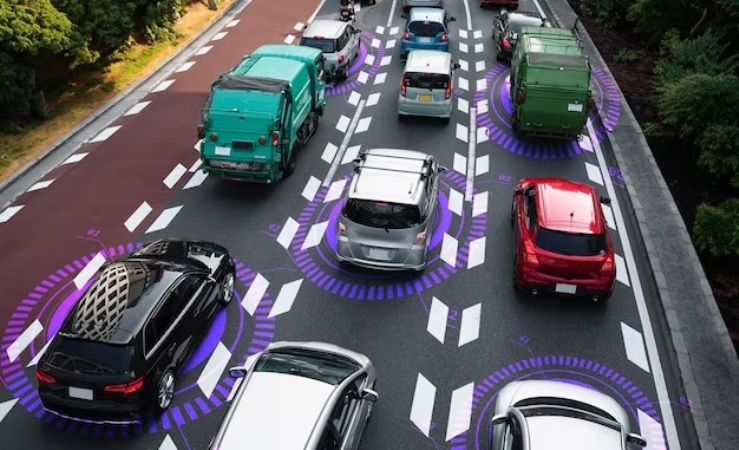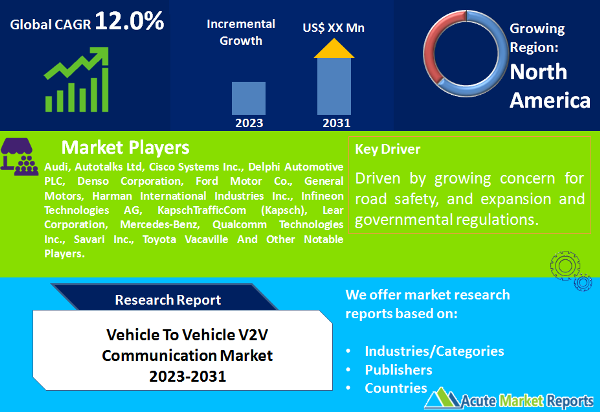
In a world where connectivity is increasingly pivotal, the vehicle-to-vehicle (v2v) communication market plays a crucial role in the automotive industry. This innovative technology allows vehicles, whether passenger or commercial, to share essential data, enhancing road safety and traffic efficiency. It's a transformative force in transportation and logistics. Vehicle to vehicle v2v communication marketis expected to grow at a CAGR of 12.0% during the forecast period of 2025 to 2033, driven by growing concern for road safety, and expansion and governmental regulations.

Technological advancements
Technological innovation is a significant driver of the v2v communication market. Companies are continuously developing new technologies to consolidate their market position. For example, in 2024, nav wireless technologies introduced advanced v2v communication technology, utilizing optical lifi for secure data sharing between military vehicles. Similarly, borgwarner's acquisition of delphi technologies in 2020 aimed to strengthen its electronics products, impacting the v2v communication market positively. These advancements highlight the industry's commitment to evolving and implementing cutting-edge technologies.
Growing concern for road safety
The increasing focus on road safety is another pivotal driver for the v2v communication market. With over 1.3 million annual deaths due to road traffic accidents, as reported by the world health organization, there is a pressing need for enhanced vehicle safety features. V2v communication can significantly contribute to this by providing real-time data exchange, reducing the risk of accidents and improving overall road safety.
Expansion and governmental regulations
The v2v communication industry is experiencing growth due to the development of wireless technology and increased information exchange. Additionally, cloud-based fleet management and governmental regulations contribute to this expansion. Government involvement and regulatory frameworks play a crucial role in facilitating the adoption of v2v communication technologies, ensuring safety standards, and promoting industry growth.
Standardization and security issues
The v2v communication market faces a significant restraint in the form of standardization and security issues. The need for protocol standardization and concerns regarding data privacy are major challenges. The implementation of v2v technology demands consensus among automotive manufacturers on funding and standard protocols. Moreover, the technology's reliance on extensive data storage raises concerns about complex processing, security, and analytics, which are barriers to market growth.
Market Segmentation by Connectivity Type
Cellular-based technology, which leverages existing cellular networks, is gaining traction due to its extensive coverage and evolving infrastructure, particularly with the advent of 5G technology. This technology is instrumental in enabling long-range communications and high-speed data transfer, essential for real-time vehicle communication. Its integration with emerging technologies like the Internet of Things (IoT) and cloud computing enhances its applicability in V2V communication, potentially leading to high revenue generation and a robust CAGR. The continued expansion of cellular network infrastructure and the push towards 5G could see this segment achieving significant growth rates and market share.
On the other hand, DSRC, a technology specifically designed for automotive communication, operates on a dedicated spectrum. It is highly reliable for short-range, direct communication between vehicles, crucial for safety-critical applications. DSRC's low latency and high reliability make it ideal for immediate, localized communication scenarios, such as collision avoidance and traffic management. While DSRC may have a lower growth rate compared to cellular-based technology due to the latter's widespread infrastructure and applicability, it remains a key technology in scenarios where instantaneous communication is paramount. The demand for DSRC could be driven by regulatory mandates and its critical role in enhancing vehicular safety, contributing to its revenue in the V2V communication market.
Market segmentation by Deployment Type
With the increasing production of connected and autonomous vehicles, OEM devices are becoming standard features, thereby boosting their market presence. OEM devices segment accounts for a significant majority of the market revenue due to the higher costs associated with these advanced technologies and their direct integration into new vehicles. The revenue from the OEM segment could be bolstered by partnerships between vehicle manufacturers and tech companies, driving innovation and integration of sophisticated V2V systems.
However, in terms of CAGR, the Aftermarket devices segment might display a higher growth rate. This could be attributed to the growing consumer demand for upgrading older vehicles with modern safety and communication features, along with the increasing affordability and availability of these aftermarket solutions. The expansion of this segment might be driven by a broader range of vehicle owners looking to retrofit their cars with advanced V2V technologies, thus reaching a larger, more diverse market.
North America leads the Market in terms of Revenue
In the geographic segmentation of the Vehicle to Vehicle (V2V) Communication Market, trends indicate varying growth and revenue patterns across regions. North America as the region with the highest revenue percentage, attributed to the advanced automotive infrastructure, high adoption rate of new technologies, and stringent safety regulations. This region, particularly the United States, is home to major automotive and technology companies actively investing in V2V communication systems. The presence of these key players, along with supportive government policies and consumer readiness to adopt new technologies, likely contributes to North America's significant share in market revenue as of 2025.In contrast, the Asia-Pacific region could be projected to have the highest Compound Annual Growth Rate (CAGR) during the forecast period of 2025 to 2033. This growth can be attributed to the rapid industrialization, increasing investments in automotive technology, and the expanding automotive market in countries like China, India, and Japan. The growing demand for vehicle safety, coupled with the rising production of vehicles equipped with advanced technologies in these emerging economies, could significantly drive the growth of the V2V communication market in the Asia-Pacific region.
Competitive Landscape
Regarding competitive trends, the V2V communication market is characterized by the presence of several key players, each employing distinct strategies to consolidate their market position. Companies like Audi, Autotalks Ltd, Cisco Systems Inc., Delphi Automotive PLC, Denso Corporation, Ford Motor Co., General Motors, Harman International Industries Inc., Infineon Technologies AG, KapschTrafficCom (Kapsch), Lear Corporation, Mercedes-Benz, Qualcomm Technologies Inc., Savari Inc., and Toyota Vacaville are to be among the top players. These companies are likely focusing on strategic collaborations, mergers and acquisitions, and research and development initiatives to enhance their product offerings and expand their market presence. For instance, collaborations between automotive manufacturers and technology companies are common to integrate advanced V2V communication systems into new vehicle models. Additionally, investments in research and development for improving the efficiency, reliability, and security of V2V systems are pivotal in maintaining competitive advantage.
The key strategies of these companies might include focusing on innovation, expanding their geographical reach, and adapting to evolving regulatory standards. For example, a company like Qualcomm could be investing heavily in developing more advanced communication chips that are integral to V2V systems, while Toyota might be integrating these systems into their new vehicle models to enhance safety features. In terms of revenue, these companies are likely to have reported significant figures in 2024, with forecasts showing continued growth due to the increasing demand for safer and more efficient transportation systems globally during the 2025 to 2033 period.
Historical & Forecast Period
This study report represents analysis of each segment from 2023 to 2033 considering 2024 as the base year. Compounded Annual Growth Rate (CAGR) for each of the respective segments estimated for the forecast period of 2025 to 2033.
The current report comprises of quantitative market estimations for each micro market for every geographical region and qualitative market analysis such as micro and macro environment analysis, market trends, competitive intelligence, segment analysis, porters five force model, top winning strategies, top investment markets, emerging trends and technological analysis, case studies, strategic conclusions and recommendations and other key market insights.
Research Methodology
The complete research study was conducted in three phases, namely: secondary research, primary research, and expert panel review. key data point that enables the estimation of Vehicle To Vehicle V2V Communication market are as follows:
Market forecast was performed through proprietary software that analyzes various qualitative and quantitative factors. Growth rate and CAGR were estimated through intensive secondary and primary research. Data triangulation across various data points provides accuracy across various analyzed market segments in the report. Application of both top down and bottom-up approach for validation of market estimation assures logical, methodical and mathematical consistency of the quantitative data.
| ATTRIBUTE | DETAILS |
|---|---|
| Research Period | 2023-2033 |
| Base Year | 2024 |
| Forecast Period | 2025-2033 |
| Historical Year | 2023 |
| Unit | USD Million |
| Segmentation | |
Connectivity Type
| |
Deployment Type
| |
Technology
| |
Application
| |
End-Use
| |
|
Region Segment (2023-2033; US$ Million)
|
Key questions answered in this report